300 scholarly books by Brandeis University Press and 14
start with R
300 scholarly books by Brandeis University Press and 14
300 scholarly books by Brandeis University Press
14 start with R start with R
14 start with R start with R
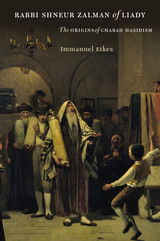
Rabbi Shneur Zalman of Liady
The Origins of Chabad Hasidism
Immanuel Etkes
Brandeis University Press, 2014
Rabbi Shneur Zalman of Liady (1745–1812), in imperial Russia, was the founder and first rebbe of Chabad, a branch of Hasidic Judaism that flourishes to the present day. The Chabad-Lubavitch movement he founded in the region now known as Belarus played, and continues to play, an important part in the modernization processes and postwar revitalization of Orthodox Jewry. Drawing on historical source materials that include Shneur Zalman’s own works and correspondence, as well as documents concerning his imprisonment and interrogation by the Russian authorities, Etkes focuses on Zalman’s performance as a Hasidic leader, his unique personal qualities and achievements, and the role he played in the conflict between Hasidim and its opponents. In addition, Etkes draws a vivid picture of the entire generation that came under Rabbi Shneur Zalman’s influence. This comprehensive biography will appeal to scholars and students of the history of Hasidism, East European Jewry, and Jewish spirituality.
[more]
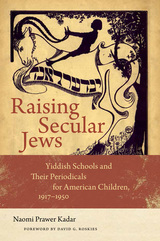
Raising Secular Jews
Yiddish Schools and Their Periodicals for American Children, 1917–1950
Naomi Prawer Kadar
Brandeis University Press, 2016
This unique literary study of Yiddish children’s periodicals casts new light on secular Yiddish schools in America in the first half of the twentieth century. Rejecting the traditional religious education of the Talmud Torahs and congregational schools, these Yiddish schools chose Yiddish itself as the primary conduit of Jewish identity and culture. Four Yiddish school networks emerged, which despite their political and ideological differences were all committed to propagating the Yiddish language, supporting social justice, and preparing their students for participation in both Jewish and American culture. Focusing on the Yiddish children’s periodicals produced by the Labor Zionist Farband, the secular Sholem Aleichem schools, the socialist Workmen’s Circle, and the Ordn schools of the Communist-aligned International Workers Order, Naomi Kadar shows how secular immigrant Jews sought to pass on their identity and values as they prepared their youth to become full-fledged Americans.
[more]

A Reader’s Delight
Noel Perrin
Brandeis University Press, 1988
Reader’s Delight
[more]
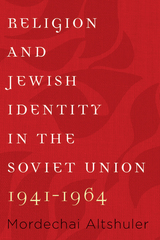
Religion and Jewish Identity in the Soviet Union, 1941–1964
Mordechai Altshuler
Brandeis University Press, 2012
This illuminating study explores the role of religious institutions in the makeup of Jewish identity in the former Soviet Union, against the backdrop of the government’s antireligion policies from the 1940s to the 1960s. Foregrounding instances of Jewish public and private activities centered on synagogues and prayer groups—paradoxically the only Jewish institutions sanctioned by the government—Altshuler dispels the commonly held perception of Soviet Jewry as “The Jews of Silence” and reveals the earliest stirrings of Jewish national sentiment that anticipated the liberation movement of the 1960s and 1970s.
[more]
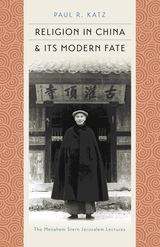
Religion in China and Its Modern Fate
Paul R. Katz
Brandeis University Press, 2014
Paul R. Katz has composed a fascinating account of the fate of Chinese religions during the modern era by assessing mutations of communal religious life, innovative forms of religious publishing, and the religious practices of modern Chinese elites traditionally considered models of secular modernity. The author offers a rare look at the monumental changes that have affected modern Chinese religions, from the first all-out assault on them during the 1898 reforms to the eve of the Communist takeover of the mainland. Tracing the ways in which the vast religious resources (texts, expertise, symbolic capital, material wealth, etc.) that circulated throughout Chinese society during the late imperial period were reconfigured during this later era, Katz sheds new light on modern Chinese religious life and the understudied nexus between religion and modern political culture. Religion in China and Its Modern Fate will appeal to a broad audience of religionists and historians of modern China.
[more]
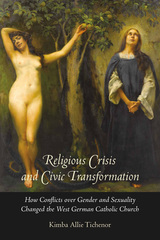
Religious Crisis and Civic Transformation
How Conflicts over Gender and Sexuality Changed the West German Catholic Church
Kimba Allie Tichenor
Brandeis University Press, 2016
This book offers a fresh interpretation of the connection between the West German Catholic Church and post-1950s political debates on women’s reproductive rights and the protection of life in West Germany. According to Tichenor, Catholic women in West Germany, influenced by the culture of consumption, the sexual revolution, Vatican II reforms, and feminism, sought to renegotiate their relationship with the Church. They demanded a more active role in Church ministries and challenged the Church’s hierarchical and gendered view of marriage and condemnation of artificial contraception. When the Church refused to compromise, women left en masse. In response, the Church slowly stitched together a new identity for a postsecular age, employing an elaborate nuptial symbolism to justify its stance on celibacy, women’s ordination, artificial contraception, abortion, and reproductive technologies. Additionally, the Church returned to a radical interventionist agenda that embraced issue-specific alliances with political parties other than the Christian parties. In her conclusion, Tichenor notes more recent setbacks to the German Catholic Church, including disappointment with the reactionary German Pope Benedict XVI and his failure in 2010 to address over 250 allegations of sexual abuse at twenty-two of Germany’s twenty-seven dioceses. How the Church will renew itself in the twenty-first century remains unclear. This closely observed case study, which bridges religious, political, legal, and women’s history, will interest scholars and students of twentieth-century European religious history, modern Germany, and the intersection of Catholic Church practice and women’s issues.
[more]

Representing the French Revolution
Literature, Historiography, and Art
Edited by James A. W. Heffernan
Brandeis University Press, 1992
Why is the anniversary of the French Revolution celebrated on July 14, the day the Bastille was stormed, rather than on August 26, the day the Declaration of the Rights of Man was signed? Why don’t the French do as the Americans, who see their revolution epitomized by the signing of the Declaration of Independence? “There is surely something to be learned from contemplating the difference between these two ways of representing a revolution,” writes James Heffernan. In this volume, he and 13 other distinguished scholars consider representations of the French Revolution in literature, historical narratives, and art as central to understanding it. Challenging the idea that history is a body of fact separable from fictions wrought by literature and the visual arts, they show that study of a major historical event inevitably leads to study of representation.
[more]
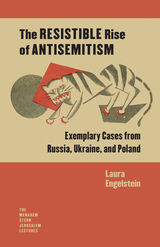
The Resistible Rise of Antisemitism
Exemplary Cases from Russia, Ukraine, and Poland
Laura Engelstein
Brandeis University Press, 2020
Antisemitism emerged toward the end of the nineteenth century as a powerful political movement with broad popular appeal. It promoted a vision of the world in which a closely-knit tribe called “the Jews” conspired to dominate the globe through control of international finance at the highest levels of commerce and money lending in the towns and villages. This tribe at the same time maneuvered to destroy the very capitalist system it was said to control through its devotion to the cause of revolution. It is easy to draw a straight line from this turn-of-the-century paranoid thinking to the murderous delusions of twentieth-century fascism. Yet the line was not straight.
Antisemitism as a political weapon did not stand unchallenged, even in Eastern Europe, where its consequences were particularly dire. In this region, Jewish leaders mobilized across national borders and in alliance with non-Jewish public figures on behalf of Jewish rights and in opposition to anti-Jewish violence. Antisemites were called to account and forced on the defensive. In Imperial and then Soviet Russia, in newly emerging Poland, and in aspiring Ukraine—notorious in the West as antisemitic hotbeds—antisemitism was sometimes a moral and political liability. These intriguing essays explore the reasons why, and they offer lessons from surprising places on how we can continue to fight antisemitism in our times.
Antisemitism as a political weapon did not stand unchallenged, even in Eastern Europe, where its consequences were particularly dire. In this region, Jewish leaders mobilized across national borders and in alliance with non-Jewish public figures on behalf of Jewish rights and in opposition to anti-Jewish violence. Antisemites were called to account and forced on the defensive. In Imperial and then Soviet Russia, in newly emerging Poland, and in aspiring Ukraine—notorious in the West as antisemitic hotbeds—antisemitism was sometimes a moral and political liability. These intriguing essays explore the reasons why, and they offer lessons from surprising places on how we can continue to fight antisemitism in our times.
[more]
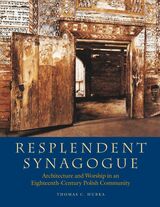
Resplendent Synagogue
Architecture and Worship in an Eighteenth-Century Polish Community
Thomas C. Hubka
Brandeis University Press, 2022
This unique exploration of a lost religious and cultural artifact breathes new life into a forgotten but fascinating aspect of eighteenth-century Polish Jewry.
Thomas C. Hubka, an architectural historian, immersed himself in medieval and early modern Jewish history, religion, and culture to prepare for this remarkable study of the eighteenth-century Polish synagogue in the town of Gwozdziec, now in present-day Ukraine. Because the Gwozdziec Synagogue, like so many others, was destroyed by the Nazis, this book revives a spiritual community lost to history. Hubka selected the Gwozdziec Synagogue because of the completeness of its photographic and historical records. Graced with nearly two hundred historical photographs, architectural drawings, maps, diagrams, and color illustrations, Resplendent Synagogue vividly recreates the spiritual heart of a once-vibrant Jewish population. Hubka demonstrates that while the architectural exterior of the synagogue was largely the product of non-Jewish, regional influences, the interior design and elaborate wall-paintings signified a distinctly Jewish art form. The collaboration of Jewish and Gentile builders, craftsmen, and artists in the creation of this magnificent wooden structure attests to an eighteenth-century period of relative prosperity and communal well-being for the Jews of Gwozdziec. Part of a tradition that was later abandoned by Eastern European Jewish communities in the nineteenth and twentieth centuries, this truly resplendent synagogue exemplified a high point in Jewish architectural art and religious painting.
Thomas C. Hubka, an architectural historian, immersed himself in medieval and early modern Jewish history, religion, and culture to prepare for this remarkable study of the eighteenth-century Polish synagogue in the town of Gwozdziec, now in present-day Ukraine. Because the Gwozdziec Synagogue, like so many others, was destroyed by the Nazis, this book revives a spiritual community lost to history. Hubka selected the Gwozdziec Synagogue because of the completeness of its photographic and historical records. Graced with nearly two hundred historical photographs, architectural drawings, maps, diagrams, and color illustrations, Resplendent Synagogue vividly recreates the spiritual heart of a once-vibrant Jewish population. Hubka demonstrates that while the architectural exterior of the synagogue was largely the product of non-Jewish, regional influences, the interior design and elaborate wall-paintings signified a distinctly Jewish art form. The collaboration of Jewish and Gentile builders, craftsmen, and artists in the creation of this magnificent wooden structure attests to an eighteenth-century period of relative prosperity and communal well-being for the Jews of Gwozdziec. Part of a tradition that was later abandoned by Eastern European Jewish communities in the nineteenth and twentieth centuries, this truly resplendent synagogue exemplified a high point in Jewish architectural art and religious painting.
[more]
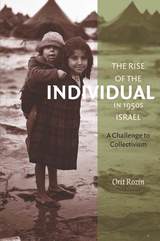
The Rise of the Individual in 1950s Israel
A Challenge to Collectivism
Orit Rozin
Brandeis University Press, 2011
In this sharply argued volume, Orit Rozin reveals the flaws in the conventional account of Israeli society in the 1950s, which portrayed the Israeli public as committed to a collectivist ideology. In fact, major sectors of Israeli society espoused individualism and rejected the state-imposed collectivist ideology. Rozin draws on archival, legal, and media sources to analyze the attitudes of black-market profiteers, politicians and judges, middle-class homemakers, and immigrants living in transit camps and rural settlements. Part of a refreshing trend in recent Israeli historiography to study the voices, emotions, and ideas of ordinary people, Rozin’s book provides an important corrective to much extant scholarly literature on Israel’s early years.
[more]
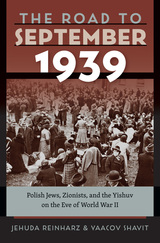
The Road to September 1939
Polish Jews, Zionists, and the Yishuv on the Eve of World War II
Jehuda Reinharz and Yaacov Shavit
Brandeis University Press, 2018
In European and Holocaust historiography, it is generally believed that neither the Zionist movement nor the Yishuv were mindful of the plight of European Jews in the face of the Nazi threat during the 1930s. Drawing on a wide variety of memoirs, letters, and institutional reports by people from all walks of life, this volume sheds new light on a troubled period in Jewish history. Jehuda Reinharz and Yaacov Shavit trace Jewish responses to developments in Eastern and Central Europe, as well as reactions to British policy on the question of a Jewish homeland, to show that Zionists in the Yishuv worked tirelessly on the international stage on behalf of their coreligionists in Europe. Nevertheless, their efforts were all too often shattered by the realities of their powerlessness and lack of resources. Piercing to the heart of conversations about how or whether to save Jews in an increasingly hostile Europe, this volume provides a nuanced assessment of what could and could not be achieved in the years just prior to World War II and Holocaust.
[more]
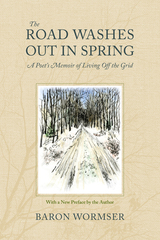
The Road Washes Out in Spring
A Poet’s Memoir of Living Off the Grid
Baron Wormser
Brandeis University Press, 2023
A new edition of an evergreen back-to-nature book in the tradition of Thoreau.
For nearly twenty-five years, poet Baron Wormser and his family lived in a house in Maine with no electricity or running water. They grew much of their own food, carried water by hand, and read by the light of kerosene lamps. They considered themselves part of the “back to the land” movement, but their choice to live off the grid was neither a statement nor a protest: they simply had built their house too far from the road and could not afford to bring in power lines. Over the years, they settled into a life that centered on what Thoreau would have called “the essential facts.” In this graceful meditation, Wormser similarly spurns ideology in favor of observation, exploration, and reflection. “When we look for one thread of motive,” he writes, “we are, in all likelihood, deceiving ourselves.” His refusal to be satisfied with the obvious explanation, the single thread of motive, makes him a keen and sympathetic observer of his neighbors and community, a perceptive reader of poetry and literature, and an honest and unselfconscious analyst of his own responses to the natural world. The result is a series of candid personal essays on community and isolation, nature, civilization, and poetry. Lovely and rich, The Road Washes Out in Spring is an immersive read. A new preface by the author rounds out this new edition.
For nearly twenty-five years, poet Baron Wormser and his family lived in a house in Maine with no electricity or running water. They grew much of their own food, carried water by hand, and read by the light of kerosene lamps. They considered themselves part of the “back to the land” movement, but their choice to live off the grid was neither a statement nor a protest: they simply had built their house too far from the road and could not afford to bring in power lines. Over the years, they settled into a life that centered on what Thoreau would have called “the essential facts.” In this graceful meditation, Wormser similarly spurns ideology in favor of observation, exploration, and reflection. “When we look for one thread of motive,” he writes, “we are, in all likelihood, deceiving ourselves.” His refusal to be satisfied with the obvious explanation, the single thread of motive, makes him a keen and sympathetic observer of his neighbors and community, a perceptive reader of poetry and literature, and an honest and unselfconscious analyst of his own responses to the natural world. The result is a series of candid personal essays on community and isolation, nature, civilization, and poetry. Lovely and rich, The Road Washes Out in Spring is an immersive read. A new preface by the author rounds out this new edition.
[more]
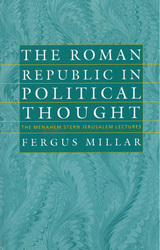
The Roman Republic in Political Thought
Fergus Millar
Brandeis University Press, 2002
It is a fact that the very long-lived Roman Republic has consistently played a surprisingly slight role in political theory and discussions about the nature of democracy, forms of government, and other matters, particularly when compared to the enormous attention paid to fifth-century BCE Athenian democracy. Fergus Millar re-opens the issue of how the Roman Republic was understood and used by political thinkers from the Ancient World to the present. Describing both the reality of the late Roman Republic and showing how its nature was distorted even by contemporary sources, he tracks its treatment (or absence) in political discourse from Thomas Aquinas, Machiavelli, Montesquieu, and Rousseau, and in debates surrounding the creation of the American constitution, particularly in the Federalist papers. In brief, clear prose, with quotations in English from important works, and economical use of endnotes, he reinforces his unconventional thesis about the significance of direct democracy in the late Roman Republic. In the process, he also provides an unprecedented tour through 2000 years of Western political theory from the point of view of the Roman Republic, in general, and theories of direct democracy and the balance of power, in particular.
[more]
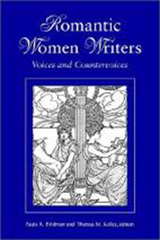
Romantic Women Writers
Voices and Countervoices
Paula R. Feldman and Theresa M. Kelley
Brandeis University Press, 1995
Essays forging a new definition of Romanticism that includes the wide range of women's artistic expression.
[more]
READERS
Browse our collection.
PUBLISHERS
See BiblioVault's publisher services.
STUDENT SERVICES
Files for college accessibility offices.
UChicago Accessibility Resources
home | accessibility | search | about | contact us
BiblioVault ® 2001 - 2024
The University of Chicago Press









